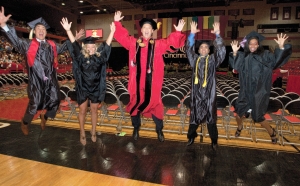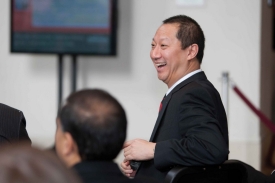July 2014
Archive of President Ono's magazine letters
@PrezOno:
This I Believe
The esteemed journalist Edward Murrow launched the “This I Believe” radio program in the 1950s to get people talking about the core beliefs that grounded, guided and sustained their daily lives. National Public Radio resurrected the concept in 2005, and I always found myself drawn to the clarity and conviction at the heart of this exercise.
But it wasn’t until recently—in reflecting back on my career as a professor, administrator and lifelong learner—that I put pen to paper. Here’s what I believe.
I believe in believing—in others and in something bigger than ourselves.
I believe in the power of diversity and the promise of inclusion.
I believe in first impressions and second chances.
And I believe in helping everyone get where they want to go.
I believe music is medicine.
I believe caring is contagious.
I believe a good laugh is a great thing.
And I believe no kind act is too big or small.
I believe in heroes.
I believe in dreamers.
I believe in teamwork.
And I believe in leaders eating last.
I believe teaching is a calling.
I believe learning is a passport.
I believe research is a lifeline.
And I believe the world has yet to see the best from higher education.
Above all, I believe the possibilities are limitless.
Because I believe all of these things, I especially believe in the University of Cincinnati. Every day our remarkably dedicated faculty, staff and alumni empower our students to develop, test, stretch, share and celebrate their ideas, aspirations, values and beliefs. And, in turn, they inspire us to continually refresh our own personal philosophies.
October 2013
Campaign: 'Ambitious, monumental, staggering'
$1 billion from 100,000 unique donors puts UC in select company
We did it. We set a highly ambitious goal of raising $1 billion in philanthropic support, and we surpassed that mark a full five months before the campaign’s official endpoint of June 30, 2013.
This is a monumental achievement and not just because of one giant number. The real key to this milestone is not that we raised it, but how we did so — and the incredible impact it will have on our campus and out in the world.
I certainly don’t want to downplay that dollar figure because it puts us in some very select company. Fewer than 2 percent of all colleges and universities in the country have ever raised so much, and you can probably name several of them without trying: Stanford, UCLA, Berkeley, Michigan and Penn State. But here are some numbers that strike me as even more important.
First, 100,000 unique donors made this possible. Think about that. Even for a place with as much history as the University of Cincinnati, that’s a staggering figure. To put it in perspective, imagine the entire population of cities like Boulder, Green Bay or South Bend, Ind., reaching into their pockets simultaneously to give money to a university campaign.
Perhaps even more stunning is that fully half of those people were first-time donors. The range of donors is startling, too, whether you look at who or where.
Roughly 60 percent of donors are alumni, meaning not only that our alumni believe strongly in the UC mission but that 40,000 non-alumni do, too. About a third of donations came from outside Cincinnati — New York, Atlanta, Chicago, Northern California, all over — which makes a statement about UC’s growing reach. And some $65 million came from our own faculty and staff, which says something about people’s willingness to invest in the future of a place they love.
The spirit behind this outpouring is both thrilling and humbling, especially when you think about the concrete changes it will make. Thanks to your generosity, 530 new scholarships have already been created, 23 faculty chairs endowed, and beautiful campus facilities planned or upgraded.
We will continue to attract and retain world-class faculty and students. We will push forward with new research into Alzheimer’s and Parkinson’s, as well as the areas of business, law, religion, engineering and so many fields connected to so many lives.
We have many folks to thank for all of this, including campaign co-chairs Otto Budig and Buck Niehoff; Steve Wilson, chairman and interim president of the University of Cincinnati Foundation at the time; and all the staff and volunteers who worked to make “Proudly Cincinnati” a success.
But without the “you” in UC, reading this now, the university and its work literally couldn’t exist, much less be on the amazing trajectory of these last few years.
I’m as “proudly Cincinnati” as anyone. So after all the stats and numbers, finally and simply, I say, “Thank you.”
April 2013
Face-to-face connections trump everything
As I continue my national tour to meet with alumni and friends — we’re calling it the #HottestCollegeinAmerica 2013 Tour — I’ve been thinking about the ways we interact and how we know what we know in this restlessly mobile and technologically privileged century.
We certainly seem to know more and more about each other by way of LinkedIn, Instagram, Facebook, Twitter and others. Search engines flash results in a sliver of a second, and a few clicks can tell us someone’s address, what she paid for her house, what he looked like in high school and even how many jobs he has had since then.
But I’m hardly the first to wonder how much of this counts as knowing. Indispensable as the Internet is, information has never been the same as knowledge. The digital universe does “surfaces” best: the précis, the front page, the link, the chart, the retort.
Knowledge requires depth. And while there is plenty of false information out there — probably inevitable in a largely unregulated medium — there can be a deeper falseness, ironically, in the World Wide Web’s sense of depth.
The Internet is more mirror than lake. In tailoring links and topics and even ads to our personal predilections, it gives us back mainly an image of ourselves while fooling us into thinking we’ve plumbed rather than skimmed.
As far-flung and busy as we all are in 2013, we could hardly function without these miraculous distance-spanning technologies. (And it’s worth remembering that the telegraph, telephone and even snail mail were once revolutionary, too.) But as I meet more and more of the students, faculty, parents, staff and alumni who make up the Bearcat family, I realize that there’s no substitute for face-to-face.
This double-edged blade — connection without contact — cuts across research and business no less than social media. Scholarship and discovery, two things UC is very good at, benefit mightily from the modern ability to share data. Certainly no researcher yearns for a world gone by in which (just to choose one field) Gregor Mendel’s pioneering work in genetics could be unknown for decades and Charles Darwin could be alerted only by a handwritten letter in the post to a career’s worth of parallel work by Alfred Wallace.
But then as now, much of what drives discovery is hands-on work in the field, the lab and the library, and many a research idea is sparked by conversation in the hallway or cafeteria. Nothing trumps the human connection.
I know it will be fun meeting many of you and getting reacquainted with others this spring in a place close to your home, where we can talk about UC or whatever else is on your mind.
In the meantime, I hope you enjoy reading these wonderful stories about things you may never have known about UC. They remind us that the telling details of someone’s life and work, and the dreams and quirks that give texture to any personal portrait, rarely show up on Google or get fully captured in a Tweet.
Hope to see you — really see you — soon.

Santa J. Ono, President, University of Cincinnati


